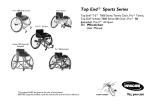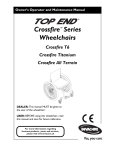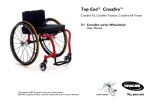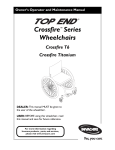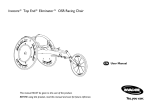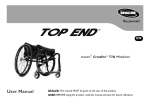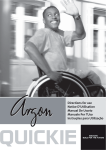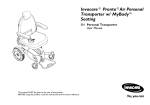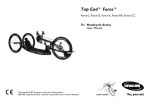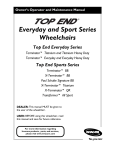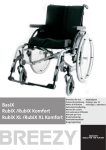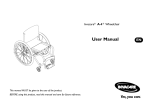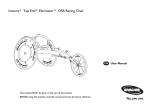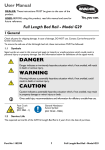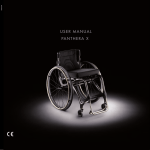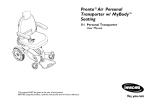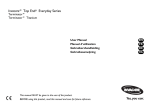Download Owner`s Manual
Transcript
Top End® Sports Series Top End®T-5™ 7000 Series Tennis Chair, Pro™Tennis, Top End®Schulte 7000 Series BB Chair, Pro™ BB Basketball, Pro-2™ All Sport EN Wheelchair User Manual This manual MUST be given to the user of the product. BEFORE using this product, read this manual and save for future reference. ©2013 Invacare®Corporation All rights reserved. Republication, duplication or modification in whole or in part is prohibited without prior written permission from Invacare. Trademarks are identified by ™and ®. All trademarks are owned by or licensed to Invacare Corporation or its subsidiaries unless otherwise noted. Shimano is a registered trademark of Shimano, Inc. Sun is a registered trademark of Sun Components, Inc. 3–in-1 oil is a registered trademark of American Home Products Corporation WD-40 is a registered trademark of WD-40 Company Loctite 242 is a trademark of the Loctite Corporation Teflon is a registered trademark of E.I. Du Pont De Nemours and Company Please record your serial number SN#_________________. The SN is required for any warranty claims and placing aftermarket parts orders. 5 Contents 1 General . . . . . . . . . . . . . . . . . . . . . . . . . . . . . . . . . . . . . . 5 1.1 Symbols. . . . . . . . . . . . . . . . . . . . . . . . . . . . . . . . . . 5 1.2 Intended Use . . . . . . . . . . . . . . . . . . . . . . . . . . . . . . 5 1.3 Dealer/Technician Information . . . . . . . . . . . . . . . . . 5 2 Safety. . . . . . . . . . . . . . . . . . . . . . . . . . . . . . . . . . . . . . . . 6 2.1 General Safety . . . . . . . . . . . . . . . . . . . . . . . . . . . . . 6 2.2 Reaching, Leaning and Bending . . . . . . . . . . . . . . . . . 6 2.3 Transferring To and From Other Seats . . . . . . . . . . . 7 2.4 Stability and Balance . . . . . . . . . . . . . . . . . . . . . . . . . 8 2.5 Safety Inspection Checklist . . . . . . . . . . . . . . . . . . . . 9 3 Overview . . . . . . . . . . . . . . . . . . . . . . . . . . . . . . . . . . . . . 3.1 Label Location . . . . . . . . . . . . . . . . . . . . . . . . . . . . . 3.2 Typical Product Parameters . . . . . . . . . . . . . . . . . . . 3.3 Component Identification . . . . . . . . . . . . . . . . . . . . . 3.4 Tire Pressure Conversion. . . . . . . . . . . . . . . . . . . . . 11 11 12 19 24 Setup . . . . . . . . . . . . . . . . . . . . . . . . . . . . . . . . . . . . . . . . 4.1 Components . . . . . . . . . . . . . . . . . . . . . . . . . . . . . . 4.2 Tools . . . . . . . . . . . . . . . . . . . . . . . . . . . . . . . . . . . 4.3 Adjusting and Installing the Wheels . . . . . . . . . . . . . . 4.4 Installing Adjustable Anti-tip Wheel. . . . . . . . . . . . . . 4.5 Attaching the L Brackets. . . . . . . . . . . . . . . . . . . . . . 4.6 Attaching the Curved Brackets to the Seat Frame . . . . . . . . . . . . . . . . . . . . . . . . . . . . . . . . . . . 4.7 Attaching the Seat Frame to the Base Frame . . . . . . . 4.8 Attaching the Curved Brackets to the Base Frame . . . . . . . . . . . . . . . . . . . . . . . . . . . . . . . . . . . 4.9 Attaching the Footrest . . . . . . . . . . . . . . . . . . . . . . . 4.10 Attaching the Foot strap. . . . . . . . . . . . . . . . . . . . . . 25 25 26 26 27 28 4 30 31 32 33 33 6 Wheelchair Operation . . . . . . . . . . . . . . . . . . . . . . . . . . 5.1 Operating Information . . . . . . . . . . . . . . . . . . . . . . . 5.2 Optional Folding Back . . . . . . . . . . . . . . . . . . . . . . . 5.3 Unfolding/Folding the Back . . . . . . . . . . . . . . . . . . . . 5.4 Replacing Adjustable Tension Back Upholstery . . . . . . 5.5 Adjusting Back Height/Back Upholstery . . . . . . . . . . . 5.6 Removing Play from Rear Wheels . . . . . . . . . . . . . . . 5.7 Preventing Play in Rear Wheels. . . . . . . . . . . . . . . . . 5.8 Adjusting Quick-Release Axles . . . . . . . . . . . . . . . . . 5.9 Determining Toe In/Toe Out . . . . . . . . . . . . . . . . . . 5.10 Adjusting Center of Gravity . . . . . . . . . . . . . . . . . . . 5.11 Adjusting Wheelbase Width . . . . . . . . . . . . . . . . . . . 5.12 Fork . . . . . . . . . . . . . . . . . . . . . . . . . . . . . . . . . . . . 5.13 Adjusting Seat Height for Top End Pro Tennis, Top End Pro BB, and Top End Pro-2™ All Sport. . . . . . . . 5.14 Removing/Installing the Seat Rail Extensions. . . . . . . . 5.15 Replacing/Adjusting Tubular Footrest . . . . . . . . . . . . 5.16 Replacing/Adjusting Pro-2™ All Sport Tubular Footrest . . . . . . . . . . . . . . . . . . . . . . . . . . . . . . . . . 5.17 Replacing/Adjusting Adjustable Angle Footplate. . . . . . . . . . . . . . . . . . . . . . . . . . . . . . . . . 5.18 Adjusting the Platform Footrest System . . . . . . . . . . . 5.19 Removing/Installing the Footrest Click strap. . . . . . . . 5.20 Adjusting Height of Swivel Anti-tip Caster . . . . . . . . . 5.21 Adjusting the Height of the Telescoping Anti-tip . . . . . . . . . . . . . . . . . . . . . . . . . . . . . . . . . . 34 34 36 36 39 40 42 42 42 43 44 46 47 Service . . . . . . . . . . . . . . . . . . . . . . . . . . . . . . . . . . . . . . . 6.1 Removing/Installing Rear Wheels. . . . . . . . . . . . . . . . 6.2 Handrim Replacement . . . . . . . . . . . . . . . . . . . . . . . 6.3 Repairing/Replacing Rear Wheel Tire/Tube . . . . . . . . 6.4 Replacing Front Caster/Wheels and Anti-tip Wheels . . . . . . . . . . . . . . . . . . . . . . . . . . . . . . . . . . 6.5 Replacing Adjustable Tension Seat Upholstery . . . . . . 56 56 57 58 48 50 51 52 52 53 54 54 55 58 59 6.6 6.7 6.8 Installing/Replacing the Pro-2™ All Sport Adjustable Seat Upholstery . . . . . . . . . . . . . . . . . . . . 60 Replacing Pro-2™ All Sport Screw-on Seat Upholstery . . . . . . . . . . . . . . . . . . . . . . . . . . . . . . . 60 Removing/Installing Screw-On Side Guards . . . . . . . . 61 7 Troubleshooting . . . . . . . . . . . . . . . . . . . . . . . . . . . . . . . 62 7.1 Troubleshooting . . . . . . . . . . . . . . . . . . . . . . . . . . . 62 8 Maintenance . . . . . . . . . . . . . . . . . . . . . . . . . . . . . . . . . . 64 8.1 Suggested Maintenance Procedures . . . . . . . . . . . . . . 64 9 Options . . . . . . . . . . . . . . . . . . . . . . . . . . . . . . . . . . . . . . 9.1 Using the Alignment Gauge. . . . . . . . . . . . . . . . . . . . 9.2 Installing the Clamp-on Sideguard . . . . . . . . . . . . . . . 9.3 Installing/Adjusting the Fold-in Sideguards . . . . . . . . . 9.4 Click strap for Pro™ Tennis and Pro™ BB Basketball . . . . . . . . . . . . . . . . . . . . . . . . . . . . . . . . 9.5 Click strap for Schulte 7000 BB Series . . . . . . . . . . . . 9.6 Additional Options. . . . . . . . . . . . . . . . . . . . . . . . . . 65 65 66 66 10 Warranty. . . . . . . . . . . . . . . . . . . . . . . . . . . . . . . . . . . . . 10.1 Warranty . . . . . . . . . . . . . . . . . . . . . . . . . . . . . . . . 10.2 European, Australian, and New Zealand Limited Warranty and Customer Service Information. . . . . . . 10.3 Usability Survey . . . . . . . . . . . . . . . . . . . . . . . . . . . . 70 70 68 68 69 72 74 General 1 General 1.1 Symbols Warnings Signal words are used in this manual and apply to hazards or unsafe practices which could result in personal injury or property damage. See the information below for definitions of the signal words. WARNING! – Warning indicates a potentially hazardous situation which, if not avoided, could result in death or serious injury. CAUTION! – Caution indicates a potentially hazardous situation which, if not avoided, may result in property damage or minor injury or both 1.2 Intended Use The sports wheelchair is to be used solely as a transportation device only for participating in a sports activity to assist the participant in playing the sport through self- propelling the wheelchair on the surface used. The sport chair allows the participant to engage in the sport through manual movement of the wheelchair under their own power. This wheelchair is intended for sports activities only on courts or designated playing surfaces and not intended for a daily use wheelchair or treatment of any medical condition but for recreational purposes only. Any other use is prohibited. Max. user weight: 250 lb (113.4 kg) 1.3 Dealer/Technician Information The term “qualified technician” in this manual refers to an Invacare qualified technician. IMPORTANT – Indicates a hazardous situation that could result in damage to property if it is not avoided. Gives useful tips, recommendations and information for efficient, trouble-free use. 1171910-A~15 5 Top End® Sports Series 2 Safety 2.1 General Safety The safety section contains important information for the safe operation and use of this product. WARNING! – DO NOT use this product or any available optional equipment without first completely reading and understanding these instructions and any additional instructional material such as owner’s manuals, service manuals or instruction sheets supplied with this product or optional equipment. If you are unable to understand the warnings, cautions or instructions, contact a dealer or technical personnel before attempting to use this equipment - otherwise, injury or damage may occur. – A qualified technician MUST perform the initial set up of this wheelchair. Also, a qualified technician must perform all procedures specifically indicated in the manual. NOTICE – THE INFORMATION CONTAINED IN THIS DOCUMENT IS SUBJECT TO CHANGE WITHOUT NOTICE. – Check all parts for shipping damage and test before using. In case of damage, DO NOT use. Contact Invacare/Carrier for further instruction. 2.2 Reaching, Leaning and Bending WARNING! – DO NOT attempt to reach objects if you have to move forward in the seat. – DO NOT attempt to reach objects if you have to pick them up from the floor by reaching down between your knees. – DO NOT lean over the top of the back upholstery to reach objects from behind as this may cause the wheelchair to tip over. – DO NOT shift your weight or sitting position toward the direction you are reaching as the wheelchair may tip over. WARNING! – Invacare products are specifically designed and manufactured for use in conjunction with Invacare accessories. Accessories designed by other manufacturers have not been tested by Invacare and are not recommended for use with Invacare products. 6 1171910-A~15 Safety Reaching, Leaning, or Bending Forward 2.3 Transferring To and From Other Seats WARNING! – Before attempting to transfer in or out of the wheelchair, every precaution should be taken to reduce the gap distance. Turn both casters parallel to the object you are transferring onto. Also be certain the wheel locks of your everyday chair are engaged to help prevent the wheels from moving. CAUTION! – When transferring, position yourself as far back as possible in the seat. This will help prevent damaged upholstery and the possibility of the wheelchair tipping forward. Position the front casters so that they are extended as far forward as possible and engage wheel locks. Reaching, Leaning, or Bending Backwards Transfer Instructions: 1. 2. 3. Position wheelchair as close as possible to the desired object. Point front casters forward to create the longest possible wheelbase. Reach back only as far as your arm will extend without changing your sitting position. 1171910-A~15 Position the wheelchair as close as possible alongside the seat to which you are transferring, with the front casters pointing parallel to it. Engage wheel wells on your everyday chair. Shift body weight into seat with transfer. During independent transfer, little or no seat platform will be beneath you. 7 Top End® Sports Series This activity may be performed independently provided you have adequate mobility and upper body strength. 2.4 Stability and Balance WARNING! – The position of the footrest, center of gravity, back angle, the tautness of the back upholstery as well as the user’s condition are directly related to the wheelchairs stability. Any change to one or any combination of the five conditions may cause the wheelchair to decrease in stability. Use extreme caution when using a new seating position. Anti-tippers should be adjusted to provide adequate stability. Refer to 5.20 Adjusting Height of Swivel Anti-tip Caster, page 54 or 5.21 Adjusting the Height of the Telescoping Anti-tip, page 55. CHANGE PROCEDURE FOOTREST POSITION FOOTREST POSITION P P CENTER OF GRAVITY BACK ANGLE CENTER OF GRAVITY P BACK UPHOLSTERY USER CONDITION P P BACK ANGLE BACK UPHOLSTERY USER CONDITION P P P P P P P P P P P P P If a change occurs, refer to the procedure indicated. Procedures are indicated by a checkmark in the intersecting cell of your change row and the procedure column. This will help you maintain the proper stability, safety, and handling of the wheelchair. 8 1171910-A~15 Safety 2.5 Safety Inspection Checklist Every six months, take your wheelchair to a qualified technician for a thorough inspection and servicing. Regular cleaning will reveal loose or worn parts and enhance the smooth operation of your wheelchair. To operate properly and safely, your wheelchair must be cared for just like any other vehicle. Routine maintenance will extend the life and efficiency of your wheelchair. Clean upholstery with mild soap and water or spray disinfectant using a sponge. DO NOT use bleach or wash in a washing machine. Initial adjustments should be made to suit your personal body structure and preference. Thereafter follow these maintenance procedures: Inspect/Adjust Initially q Initial adjustments should be made to suit your personal body q q q q q q q q q q q structure and preference. Thereafter follow these maintenance procedures: Inspect seat and back upholstery for rips or sagging. Inspect upholstery fastening flaps to ensure they securely latch. Inspect click strap for any signs of wear. Ensure buckle latches. Verify hardware that attaches strap to frame is secure and undamaged. Replace if necessary. Ensure quick release axles and receivers are clean. Ensure quick/quad release axles lock properly. Ensure no excessive side movement or binding when wheel is lifted and spun. Inspect handrims for signs of rough edges or peeling. Inspect spokes for bent or broken spokes. Ensure all spokes are uniformly tight. Ensure all bolts are tight. Clean upholstery. 1171910-A~15 CAUTION! – As with any vehicle, the wheels and tires should be checked periodically for cracks and wear, and should be replaced. – For more information refer to 6.1 Removing/Installing Rear Wheels, page 56. q Inspect wheel/fork assembly for proper tension by spinning caster; caster should come to a gradual stop. q Loosen/tighten locknut if wheel wobbles noticeably or binds q q q q to a stop. Ensure wheel bearings are clean and free of moisture. Inspect tires for flat spots and wear. Ensure casters are free of debris. Check that all labels are present and legible. Replace if necessary. Inspect/Adjust Weekly q q q q q q Ensure quick release axles and receivers are clean. Ensure quick/quad release axles lock properly. Inspect handrims for signs of rough edges or peeling. Inspect spokes for bent or broken spokes. Ensure all spokes uniformly tight. Ensure all bolts are tight. CAUTION! – As with any vehicle, the wheels and tires should be checked periodically for cracks and wear, and should be replaced. q Inspect wheel/fork assembly for proper tension by spinning castor; castor should come to a gradual stop. q Inspect tires for flat spots and wear. q Check for proper inflation. q Ensure castors are free of debris. 9 Top End® Sports Series Inspect/Adjust Monthly q Inspect upholstery fastening flaps to ensure they securely latch. q Inspect click strap for any signs of wear. Ensure buckle latches. Verify hardware that attaches strap to frame is secure and undamaged. Replace if necessary. CAUTION! – As with any vehicle, the wheels and tires should be checked periodically for cracks and wear, and should be replaced. q Loosen/tighten locknut if wheel wobbles noticeably or binds to a stop. q Ensure wheel bearings are clean and free of moisture. q Ensure castors are free of debris. Inspect/Adjust Periodically q Ensure wheelchair rolls straight (no excessive drag/pull to one side). q Inspect seat and back upholstery for rips or sagging. q Ensure no excessive side movement or binding when wheel is lifted and spun. q Inspect handrims for signs of rough edges or peeling. q Clean upholstery. CAUTION! – As with any vehicle, the wheels and tires should be checked periodically for cracks and wear, and should be replaced. q q q q 10 Ensure wheel bearings are clean and free of moisture. Ensure castors are free of debris. Inspect footrest bolts for rust or wear. Check that all labels are present and legible. Replace if necessary. 1171910-A~15 Overview 3 Overview 3.1 Label Location 1171910-A~15 11 Top End® Sports Series 3.2 Typical Product Parameters SCHULTE 7000 SERIES/T-5™ 7000 SERIES TENNIS FRAME: Rigid - 7005 Aluminum SEAT WIDTH: 14 - 21 inches (35.56 - 53.34 cm) - Outside to outside of seat frame in 1-inch (2.53 cm) increments SEAT DEPTH: 14 to 18-inches (35.56 - 45.72 cm) SEAT-TO-FLOOR (FIXED): Front - 141/2 to 20 7/8 inch (36.83 - 53.02 cm) Rear - 141/2 to 20 7/8 inch (36.83 - 53.02 cm) BACK STYLE: Fixed BACK HEIGHT FIXED: 8 to 15 1/2 inches (39.37 - cm) ADJUSTABLE: 9 to 11 inches (22.86 to 27.94 cm) in 1-inch (2.54 cm) increments. 11 to 14 inches (27.94 to 35.56 cm) in 1-inch (2.54 cm) increments. 14 to 18 (35.56 to 45.72 cm) in 1-inch (2.54 cm) increments. BACK ANGLE: Fixed 0° (Set at 90° to floor) WHEELBASE: 16, 17, 18, or 19 inches (40.64, 43.18, 45.72, or 48.26 cm) FOOTREST: Tubular: 4-inch (10.16 cm) Height Adjustment SIDE-WHEEL CLEARANCE: Adjustable 1/2 to 1-1/2 inches (1.27 - 3.81 cm) REAR AXLE: Fixed Axle Position, Quick Release Axle (Standard) REAR WHEEL CAMBER: Fixed: 12°, 15°, 18° or 20° 12 1171910-A~15 Overview SCHULTE 7000 SERIES/T-5™ 7000 SERIES TENNIS CHAIR REAR WHEELS*: Sun® Double Walled Rim High Flange Hub (Standard) 24–inch, 25–inch, 26–inch, 700C Sun® Sun Equalizer (Optional) 24–inch, 25–inch, 26–inch, 700C Spinergy®SLX Wheels (Optional) 24–inch, 25–inch, 26–inch, 700C REAR WHEEL TIRES: Primo 25-540 (Standard) 24–inch Kenda (Optional) Primo 25-559 (Standard) 25–inch Kenda (Optional) Primo 25-590 (Standard) 26–inch Kenda (Optional) Cheng Shin CST Super HP (Standard) 700C Kenda (Optional) HANDRIMS: Aluminum Welded 6 Tab (Standard) Aluminum Welded 12 Tab (Optional) Titanium 6 Tab (Optional) WHEEL LOCKS: N/A FRONT FORKS: Fits 3-inch (7.62 cm) Wheel Non-Suspension (Standard) CASTOR SIZE: 3-inch (7.62 cm) Solid (Standard) 1171910-A~15 13 Top End® Sports Series SCHULTE 7000 SERIES/T-5™ 7000 SERIES TENNIS CHAIR BACK UPHOLSTERY: U240 Black - Adjustable Tension WEIGHT: 21 lbs (10.89 kg) Schulte 7000, 20lbs. T5 7000 SHIPPING WEIGHT: 30 lbs (13.6 kg) WEIGHT LIMITATION: 250 lbs (114 kg), HD optional available 15 x 15-inch seat, rear wheels and minimal options are included in the weight. Refer to 3.4 Tire Pressure Conversion, page 24. All specifications are approximate. 14 1171910-A~15 Overview TOP END PRO™ TENNIS AND TOP END PRO™ BB FRAME: Rigid - 6061T6 Aluminum SEAT WIDTH: 10 to 20 inches (30.48 - 50.8 cm) - Outside to Outside of SEAT FRAME in 1-inch (2.53 cm) increments SEAT DEPTH: 10 to 18-inches (35.56 - 45.72 cm) SEAT-TO-FLOOR ADJUSTABLE: Front - 19 to 21-inch (48.26 - 53.34 cm), Rear -15 to 21-inch (38.10 - 53.34 cm) BACK STYLE: Fixed standard, Folding optional ADJUSTABLE BACK HEIGHT: 9 to 11 inches (22.86 to 27.94 cm) in 1-inch (2.54 cm) increments. 11 to 14 inches (27.94 to 35.56 cm) in 1-inch (2.54 cm) increments. 14 to 18 (35.56 to 45.72 cm) in 1-inch (2.54 cm) increments. BACK ANGLE: 0° Fixed, Adjustable Optional folding WHEELBASE: 15, 17, or 19 inches (38.10, 43.18, or 48.26 cm) FOOTREST: Recessed footrest - height and angle adjustable, adjustable forward and backward SIDE-WHEEL CLEARANCE: Adjustable 1/2 to 1-1/2 inches (1.27 - 3.81 cm) REAR AXLE: Fixed Axle with Adjustable Center of gravity position 3.5 inches to 6inches, Quick Release (Standard) REAR WHEEL CAMBER: Fixed: 15°, 18° or 20° 1171910-A~15 15 Top End® Sports Series TOP END PRO™ TENNIS AND TOP END PRO™ BB REAR WHEELS*: Sun® Double Walled Rim High Flange Hub (Standard) 24–inch, 25–inch, 26–inch Sun® Sun Equalizer Wheels (Optional) 24–inch, 25–inch, 26–inch Spinergy®SLX Wheels (Optional) 24–inch, 25–inch, 26–inch REAR WHEEL TIRES: Primo 25-540 (Standard) 24–inch Kenda (Optional) Primo 25-559 (Standard) 25–inch Kenda (Optional) Primo 25-590 (Standard) 26–inch Kenda (Optional) HANDRIMS: Aluminum Welded 6 Tab (Standard) Aluminum Welded 12 Tab (Optional) WHEEL LOCKS: N/A FRONT FORKS: Fits 3-inch (7.62 cm) Wheel Non-Suspension (Standard) CASTOR SIZE: 3-inch (7.62 cm) Solid (Standard) BACK UPHOLSTERY: U240 Black - Adjustable Tension WEIGHT: 23.5 lbs (10.66 kg) 16 1171910-A~15 Overview SHIPPING WEIGHT: 30 lbs (13.6 kg) WEIGHT LIMITATION: 250 lbs (114 kg) 15 x 15-inch seat, rear wheels and minimal options are included in the weight. Refer to 3.4 Tire Pressure Conversion, page 24. All specifications are approximate. TOP END PRO-2™ ALL SPORT FRAME: Rigid — Heat treated 7000 Series Aluminum SEAT WIDTH: 14, 16 or 18 inches SEAT DEPTH: Adjustable 13 to 17 inches SEAT-TO-FLOOR ADJUSTABLE: Front — 18 to 20 inch (45.7 to 50.8 cm), BACK STYLE: Fixed standard ADJUSTABLE BACK HEIGHT: 11 to 14 inches (27.94 to 35.56 cm) in 1–inch (2.54 cm) increments BACK ANGLE: 0° Fixed, Adjustable Optional Angle WHEELBASE: 18 inches (45.7 cm) FOOTREST: Clamp-on tubular recessed adjustable height SIDE-WHEEL CLEARANCE: Adjustable 1/2 to 1-1/2 inches (1.27 - 3.81 cm) REAR AXLE: Fixed Axle with Adjustable Center of gravity position 2.5 inches to 5 inches, Quick Release (Standard) REAR WHEEL CAMBER: Fixed: 15° 1171910-A~15 Rear — 15 to 20 inch (38.1 to 50.8 cm) 17 Top End® Sports Series TOP END PRO-2™ ALL SPORT REAR WHEELS*: Sun® Double Walled Rim High Flange Hub (Standard) 25–inch REAR WHEEL TIRES: Primo 25-559 (Standard) 25–inch HANDRIMS: Aluminum Welded 6 Tab (Standard) WHEEL LOCKS: N/A FRONT FORKS: Fits 3-inch (7.62 cm) Wheel Non-Suspension (Standard) CASTOR SIZE: 3-inch (7.62 cm) Solid (Standard) BACK UPHOLSTERY: U240 Black - Adjustable Tension WEIGHT: 23.5 lbs (10.66 kg) SHIPPING WEIGHT: 30 lbs (13.6 kg) WEIGHT LIMITATION: 250 lbs (114 kg) 15 x 15-inch seat, rear wheels and minimal options are included in the weight. Refer to 3.4 Tire Pressure Conversion, page 24. All specifications are approximate. 18 1171910-A~15 Overview 3.3 Component Identification T-5™7000 Series Tennis 1171910-A~15 19 Top End® Sports Series Pro™ Tennis 20 1171910-A~15 Overview Schulte 7000 Series BB Basketball 1171910-A~15 21 Top End® Sports Series Pro™ BB 22 1171910-A~15 Overview Pro-2™ All Sport 1171910-A~15 23 Top End® Sports Series 3.4 Tire Pressure Conversion PSI rating is printed on the side of the tire. Conversion formula: 1 psi=6.895 kPa (approx. 7 kPa). 24 PSI KILOPASCALS 90 621 95 655 PSI KILOPASCALS 100 690 50 345 105 724 55 379 110 758 60 414 115 793 65 448 120 827 70 483 75 517 80 552 85 586 1171910-A~15 Setup 4 Setup 4.1 Components A D C B E Included in the package A: • • • • • • • • • 1171910-A~15 Complete Wheel Assemblies Introductory Bonus Set of Smooth Primo Tires Base Frame B Seat Frame (Assembled with Sideguards, Upholstery, Cushion, and Frame Protector) C Footrest D Axles Adjustable Anti-tip Assembly Positioning Strap All Attaching Hardware E 25 Top End® Sports Series 4.2 Tools These tools may be needed: • • • • Adjustable Wrench 5mm Allen Wrench 4mm Allen Wrench Two 10 mm combination wrenches or socket 7/16 and 3/4 inch wrench An assistant to hold the seat frame in place while installing may also be helpful. The assembly should take about 30–45 minutes. 4.3 Adjusting and Installing the Wheels Axle receiver nut is loosely installed on axle receiver bolt. 1. 2. 26 Using the adjustable wrench A, tighten the axle receiver nut B on the axle receiver bolt C. Adjust nut on axle D so the ball bearing will lock into place when inserted through wheels and into axle receiver. 1171910-A~15 Setup 4.4 Installing Adjustable Anti-tip Wheel 1. 2. 3. Release and loosen the quick release lever A attached to the anti-tip clamp B. Insert adjustable anti-tip wheel C into base frame D with wheel facing down. Move anti-tip to desired height above ground. The anti-tip should be about a finger’s width above the ground. 4. With rear wheels on, tighten quick release lever at desired level. After installing the adjustable anti-tip wheel, rear wheels may be removed to prevent the chair from moving while installing other parts. 1171910-A~15 27 Top End® Sports Series 4.5 Attaching the L Brackets There are two sets of brackets • • The L Brackets for the front of the chair A The Curved Brackets for the read of the chair B The L Brackets are installed with four bolts of the same size. The Curved Brackets are installed with two short bolts, two longer bolts, and two single bolts (bagged separately) C. The hole you choose to mount the L bracket in will determine the center of gravity of the chair. For more information about adjusting the center of gravity refer to 5.10 Adjusting Center of Gravity, page 44. 28 1171910-A~15 Setup 1. Attach the L Brackets A to the inside of the welded tabs C on the seat frame by: a. Inserting the bolt from the inside of the seat frame D. Use one flat washer, one split washer, and one nut for each bolt. Use the two 10 mm wrenches E to hold and tighten the bolts. 1171910-A~15 29 Top End® Sports Series 4.6 Attaching the Curved Brackets to the Seat Frame 1. Remove the large bolts E from the bag and set them aside. These are extra bolts and will not be used. 2. Attach the curved brackets to the seat frame by: a. b. Aligning the curved bracket A to the inside of the welded tabs B on the seat frame. Inserting the small bolts C (bagged separately) from the outside of the seat frame through the seat frame and curved bracket. Use one flat washer, one nordlock washer, and one nut for each bolt. c. Using a 10 mm wrench and a 4 mm Allen wrench D tighten the bolt into place. Leave brackets slightly loose so they can be adjusted and attached to base frame. 30 1171910-A~15 Setup 4.7 Attaching the Seat Frame to the Base Frame 1. 2. 3. Place the seat frame on top of base frame, aligning the brackets with the tabs welded in the rear and the holes drilled in the front of the frame. Using the coped washers A and the bolts B bagged with them, attach the front L Brackets to the frame holes. Using the long bolts C set aside in 4.6 Attaching the Curved Brackets to the Seat Frame, page 30, attach the curved brackets to the welded tabs. 1171910-A~15 4. Tighten the brackets on the seat frame so the nut is as close to the seat frame as possible. 5. Place a flat and coped washer on each bolt, and insert the bolts through the drilled holes in the front of the seat frame D. Place a second coped washer E on the inside of the seat frame. Place the base frame F on top of the seat frame G and bolt and secure by tightening the nut H. 6. 7. 31 Top End® Sports Series 4.8 Attaching the Curved Brackets to the Base Frame A 1. 2. 3. 4. 32 Adjust the seat frame so the curved bracket is in the desired position and height. Line up the hole of a washer with the hole of the curved bracket on the outside of the base frame. Insert a bolt through the washer, curved bracket, and base frame A. Tighten the nut on the bolt until the nut is securely against the base frame. 1171910-A~15 Setup 4.9 Attaching the Footrest 1. 2. 3. 4. Insert two bolts A through each two part clamp B. Attach the larger side of the two-part clamps to the base frame down tube C in the desired position. Attach the other side of the two-part clamp to the footrest D. Tighten the clamp using an Allen key E. 4.10 Attaching the Foot strap 1. 2. 3. 1171910-A~15 Separate the hook and loop sections of the foot strap A. Place the foot strap around the front down tubes of the base frame B in the desired position. Connect the hook and loop sections of the foot strap. 33 Top End® Sports Series 5 Wheelchair Operation 5.1 Operating Information WARNING! WHEELCHAIR USER – As a manufacturer of wheelchairs, Invacare endeavors to supply a wheelchair to meet many needs of the end user. However, final selection of a wheelchair to be used by an individual rests solely with the user. Use this information only as a basic guide. The techniques that are discussed on the following pages have been used successfully by many. – Individual users often develop skills to deal with daily living activities that may differ from those described in this manual. Invacare recognizes and encourages each individual to try what works best for him/her in overcoming obstacles that they may encounter. – Techniques in this manual are a starting point for the wheelchair user and assistant with safety as the most important consideration for all. TRANSPORT – Invacare recommends that a wheelchair user is NOT transported in vehicles of any kind while in a wheelchair. As of this date, the Department of Transportation has not approved any tie-down systems for transportation of a user while in a wheelchair, in a moving vehicle of any type. 34 WARNING! SEAT POSITIONING STRAP – SERIOUS INJURY CAN OCCUR IN THE EVENT OF A FALL FROM THE PRODUCT. – ALWAYS use your click strap (if equipped). Invacare strongly recommends using the click strap as an additional safeguard for the wheelchair user. The click positioning strap is a positioning belt only. It is not designed for use as a safety device withstanding high stress loads such as auto or aircraft safety belts. If signs of wear appear, the belt MUST be replaced IMMEDIATELY. TIRE PRESSURE – DO NOT use your wheelchair unless it has the proper tire pressure (p.s.i.). DO NOT overinflate the tires. Failure to follow these suggestions may cause the tire to explode and cause bodily harm. The recommended tire pressure is on the sidewall of the tire. – DO NOT ride on a flat or under inflated tires. Riding on flat or under inflated tires can cause injury, as well as, damage to the tire, tube and handcycle wheels. – Replacement of the tire or tube MUST be performed by a qualified technician. WEIGHT LIMITATION – The Invacare Sport Series wheelchairs have a weight limitation of 250 lbs (114 kg). 1171910-A~15 Wheelchair Operation WARNING! RISK OF INJURY OR DAMAGE – Care, consideration and practice MUST be taken and observed in the following safety points. Otherwise, injury or damage may occur. – Safe use requires the close attention of the user as well as the assistant. This user manual points out the most common procedures and techniques involved in the safe operation and maintenance of the wheelchair. It is important to practice and master these safe techniques until you are comfortable in maneuvering the wheelchair. – The offensive wing design creates a potential foot entrapment area. Ensure the occupant’s legs and feet are properly secured during use. When transferring the occupant, ensure the feet do not slip between the wing and the footrests. – DO NOT use the footplate as a platform when getting in or out of the wheelchair. – DO NOT stand on the frame of the wheelchair. – ALWAYS use the handrims for self-propulsion. – Unless otherwise noted, all service and adjustments should be performed while the wheelchair is unoccupied. – Check all allen screws that secure the footrest system to the chair frame before using the wheelchair, especially if engaging in any contact sport. – Anti-tippers should be properly adjusted at all times. When outdoors on wet, soft ground or on gravel surfaces anti-tippers may not provide the same level of protection against tip over. Extra caution MUST be observed when traversing such surfaces. 1171910-A~15 WARNING! RISK OF INJURY OR DAMAGE – The user is responsible for normal upkeep and maintaining the wheelchair in proper operating condition. – The manufacturer is not responsible for failure, damage or injury caused by improper operation or maintenance by the end-user – To determine and establish your particular safety limits, practice transferring activities in the presence of a qualified health care professional before attempting active use of the wheelchair. – DO NOT attempt to move up or down an incline with an ice or oil film. Avoid all surface hazards. – DO NOT attempt to ride over curbs or obstacles or speed bumps. Doing so may cause your wheelchair to turn over and cause bodily harm or damage to the wheelchair. – DO NOT attempt to lift the wheelchair by any removable (detachable) parts. Lifting by means of any removable (detachable) parts of an wheelchair may result in injury to the user or damage to the wheelchair. – DO NOT carry any riders. – DO NOT carry any items that may obstruct your view or prohibit you from operating the wheelchair properly. 35 Top End® Sports Series 5.2 Optional Folding Back WARNING! RISK OF INJURY OR DAMAGE – ALWAYS perform these procedures in the presence of an assistant. The position of the footrest, center of gravity, back angle, the tautness of the back upholstery as well as the user’s condition are directly related to the stability of the wheelchair. Any change to one or any combination of the five may cause the wheelchair to decrease in stability. Use extreme caution when using a new seating position. – After any adjustments, repair or service and before use, make sure all attaching hardware is tightened securely. Otherwise injury or damage may occur. 5.3 Unfolding/Folding the Back Rear of Wheelchair Back upholstery removed for clarity 1. 2. (Only on Pro™ BB and Pro™ Tennis) WARNING! RISK OF INJURY OR DAMAGE – Back MUST be locked securely in place before using the wheelchair. To unfold the back, lift up on the back posts A and pull back towards the rear of the wheelchair until it locks into place. To fold the back, pull up the back release cord B and push the back posts forward toward the front of the wheelchair. This option is only available for Pro™ Series Sport Wheelchairs. Back Angle Adjustment Perform this procedure on both sides of the wheelchair at the same time. 1. 2. 3. 36 Front of Wheelchair Loosen, but do not remove the locknuts and allen screws A that secure the back angle bracket B to the seat rail C and the back post D. Loosen the top locknut and slide the top hex screw A away from the back angle bracket B to adjust the cam E. Adjust back post D to back angle required. 1171910-A~15 Wheelchair Operation 4. Adjust cam E to achieve desired position. An indexing notch F has been put on the cam D to help determine cam position for desired back angle adjustment. 5. Secure cam in desired position. Torque all allen screws and locknuts to 960-1020 inch pounds (80-85 foot-pounds) (9.04 9.6 newton-metres). The adjustment cam can be rotated to several different positions thus changing the overall back angle relative to the seat rail. 1171910-A~15 37 Top End® Sports Series 95° Back Angle to Seat Rail 90° Back Angle to Seat Rail 75° Back Angle to Seat Rail 85° Back Angle to Seat Rail 38 80° Back Angle to Seat Rail 1171910-A~15 Wheelchair Operation 5.4 Replacing Adjustable Tension Back Upholstery WARNING! RISK OF INJURY OR DAMAGE – The position of the footrest, seat angle, back angle, seating system/upholstery, caster size and position, rear wheel size and position, use of anti-tippers, as well as the user condition directly relate to the stability of the wheelchair. Any change to any combination of the aforementioned may cause the wheelchair to decrease in stability. EXTREME care MUST be taken when changing the stability of the wheelchair. Refer to the 2.1 General Safety, page 6 in this manual for more information. Replacing Adjustable Tension Back Upholstery 1. Both back posts A should be adjusted to the same height. 2. The straps can be adjusted at various levels of tension to accommodate individual end-users. The bottom two straps can be adjusted tightly to support and/or assist the extensor muscles. 3. Back Upholstery Cover 4. The back upholstery cover is designed for three reasons: 5. A modesty cover To keep the cushion from slide out of the back of the wheelchair A sacral support depending upon how far or tight the flap is pulled under the seat cushion 1171910-A~15 Slip adjuster straps F through corresponding anchor loops E and adjust the back upholstery. Secure with the fastening straps D. WARNING! RISK OF INJURY OR DAMAGE – After the adjustable tension back upholstery has been positioned to the end-users individual needs, the fastening straps MUST be securely fastened BEFORE applying the back upholstery cover. The adjustable back should be checked whenever entering the wheelchair to ensure that the fastening straps are securely fastened. Adjustable Tension Straps • • • Slide the existing back upholstery up and off the back posts A. 6. Secure the back upholstery cover (fastening strap) C to the back of the adjustable back upholstery (fastening strap). Flip the back upholstery cover D over the adjustable back upholstery and secure the fastening straps C to the front of the adjustable back upholstery. Lay the front portion of the back upholstery cover D on the seat pan. Adjust the slack in the back upholstery cover D and then secure to the seat pan fastening straps. 39 Top End® Sports Series 5.5 Adjusting Back Height/Back Upholstery Before unlatching the fastening flaps, observe the tautness of the back upholstery for installation. 1. Unlatch the two fastening flaps that secure the top of the back upholstery to the back posts B and remove from the back posts. WARNING! RISK OF INJURY OR DAMAGE – Push pin MUST be protruding through hole in back post. – Ensure that both back post inserts are at the same height BEFORE assembling the wheelchair. 2. 40 Press the push pin on the back post insert tube A in and adjust the back height to one of four heights depending on original back height: 1171910-A~15 Wheelchair Operation Back Height (inches) 9-11 inches 10-14 inches 12-16 inches 14 - 18 inches (CM) (22.86 - 27.94 cm) (25.40 - 35.56 cm) (30.48 - 40.64 cm) (35.56 - 45.72 cm) 1 9 (22.86 cm) 10 (25.40 cm) 12 (30.48 cm) 14 (35.56 cm) 2 10 (25.40 cm) 11 (27.94 cm) 13 (33.02 cm) 15 (38.1 cm) 3 11 (27.94 cm) 12 (30.48 cm) 14 (35.56 cm) 16 (40.64 cm) 4 N/A 13 (33.02 cm) 15 (38.10cm) 17 (43.18 cm) 5 N/A 14 (35.56 cm) 16 (40.64 cm) 18 (45.72 cm) Hole* Number *Holes numbered from bottom to top for reference only (There are no numbers on the back posts). There is a 1–inch (2.54 cm) adjustment pin on the back post insert tube. To raise back to maximum height, first make adjustment to the back post inserts. 3. Reinstall the fastening flaps onto the back posts B. The fastening flap with logo is for the left back post. Right and left is determined by sitting in the wheelchair. 4. Adjust the new back upholstery to the desired tautness. 1171910-A~15 41 Top End® Sports Series 5.6 Removing Play from Rear Wheels WARNING! RISK OF INJURY OR DAMAGE – After any adjustments, repair or service and before use, make sure all attaching hardware is tightened securely. Otherwise injury or damage may occur. With the rear wheel and quad-release axle still mounted onto the wheelchair, make the following adjustment: • Tighten the length adjusting screw until there is no in and out movement of the quad-release axle and rear wheel. 5.8 Adjusting Quick-Release Axles 1. 2. 3. 4. 5. Remove rear wheel and quick-release axle A from the wheelchair. Depress detent pin D in the quick-release axle A and slide axle through the wheel hub. Release detent pin D ensuring that the locking pins C are fully released. Increase or decrease end play by adjusting the locknut B on the end of the quick-release axle A. Install the rear wheel onto the wheelchair and ensure the wheel is securely engaged. 5.7 Preventing Play in Rear Wheels To prevent play in rear wheels install the rear wheel bolt securing lock washer system. 1. 2. 3. 4. Attach camber clamp D to wheelchair frame C. Insert bolt E through camber clamp D and tighten securely. Place washer A between axle receiver and nut assembly B and wheelchair frame C. Tighten axle receiver and nut assembly B securely. Quad-Release Axle not shown. Locking pins on the Quad-Release Axle are the same as Quick-Release Axle. 42 1171910-A~15 Wheelchair Operation 5.9 Determining Toe In/Toe Out 1. 2. 3. Inflate all pneumatic tires to recommended tire pressures (listed on the sidewall of the tire). Measure the distance between the centerlines at the rear and front of the rear wheels at approximately 12 inches (30.48 cm) from the ground/floor. • For optimum accuracy, perform STEP 2 with the wheelchair occupied. If you have an alignment gauge, refer to 9.1 Using the Alignment Gauge, page 65. Top View of Wheelchair 1171910-A~15 Determine difference between two measurements. If difference between the two measurements is greater than 1/2-inch (1.27 cm) (0 + 1/4-inch (.63 cm) for maximum rollability), one of two conditions exists: 4. If the back centerline measurement of the rear wheels is SMALLER than the front centerline measurement of the rear wheels, a TOE-OUT condition exists. • If the back centerline measurement of the rear wheels is LARGER than the front centerline measurement of the rear wheels, a TOE-IN condition exists. If the difference between the measurements is greater than 1/2-inch (1.27 cm), correct the toe-in/toe-out condition. Top View of Wheelchair 43 Top End® Sports Series 5.10 Adjusting Center of Gravity 5. Top End Pro Tennis/Top End Pro BB Models 1. 2. Equivalent Axle Position Comments 1 6 inch See Detail “B” for COG position 1 2 5 1/2 inch See Detail “B” for COG position 2 3 5 inch See Detail “B” for COG position 3 4 4 1/2 inch See Detail “B” for COG position 4 5 3. 4. 44 • • If necessary, remove the seat upholstery. Refer to 6.5 Replacing Adjustable Tension Seat Upholstery, page 59 or 6.7 Replacing Pro-2™ All Sport Screw-on Seat Upholstery, page 60. Review the following chart and determine the correct COG mounting position and then proceed to STEP 3. COG Mounting Position 4 inch See Detail “B” for COG position 5 6 3 1/2 inch See Detail “B” for COG position 6 7 3 inch See Detail “B” for COG position 7 Perform one of the following: For COG mounting positions 1-5 proceed to STEP 6 To obtain COG mounting positions 6 and 7 perform the following (Detail “C”): a. b. c. d. 6. 7. 8. 9. Remove the mounting screw A, two washers B, coved spacer C, and locknut E that secure the L-bracket D to the base frame F. Remove the L-bracket D. Secure the L-bracket B to base frame D in the position shown in Detail “D” with mounting screw, two washers, coved spacer, and locknut C. Tighten securely. Proceed to STEP 7. Secure the L-bracket B to the COG bracket A in the desired mounting position with two mounting screws and locknuts (Detail “B”). Tighten securely. Secure the L-bracket B to the COG bracket A in the desired mounting position with two mounting screws and locknuts C (Detail “D”). Tighten securely. Repeat STEP 4-6 for remaining COG bracket. If necessary, install the seat upholstery. Top End Pro™ Tennis (Not shown)/Top End Pro™ BB (Shown) Refer to images on next page. Remove the two mounting screws A and locknuts E that secure the L-bracket D to the COG bracket C on the seat rail B (Detail “A”). Repeat STEP 3 for opposite side of wheelchair. 1171910-A~15 Wheelchair Operation 1171910-A~15 Detail “A” Detail “B” Detail “C” Detail “D” 45 Top End® Sports Series T-5™7000 Series Tennis and Schulte 7000 Series BB Basketball Models 5.11 Adjusting Wheelbase Width Perform this procedure on one side of the wheelchair at a time for ease of adjustment. Adjusting Center of Gravity Option 1. 2. 3. 4. If necessary, remove the seat upholstery. Remove the four mounting screws A, coved spacers B, washer C, and locknuts D that secure the two backrest mounting brackets E to the base frame F. Secure backrest mounting brackets E to the base frame F in the desired mounting holes in the back rest mounting bracket G and the mounting holes in the base frame H with four mounting screws A, coved spacers B, washers C, and locknuts D. Tighten securely. If necessary, install the seat upholstery. Fixed Axle Tube The wheelbase width can be increased/decreased by 1–inch (2.54cm). 1. 2. 3. Remove the rear wheels Torque the axle nut A to increase/decrease the wheelbase width. Count the number of threads C showing on the axle bolt B. The number of threads showing on the axle bolt should be equal on both sides of the wheelchair. Otherwise, wheelchair performance may be affected. 4. Repeat steps 2–3 for the opposite axle nut A and axle bolt B. Axle bolt removed from axle tube D for clarity. It is not necessary to remove the axle bolt for this procedure. 46 1171910-A~15 Wheelchair Operation 5.12 Fork Fork Replacement/Adjustment/Maintenance Front Fork CAUTION! – If the stem bolt is loose, threads on the bolt may be damaged. – If this occurs, contact Invacare. The front fork should rotate freely without side-to-side movement. If any side-to-side movement occurs, tighten bolts immediately. Pro™BB/Tennis Front Fork and Anti-tip Fork Replacement 1. 2. 3. Place the empty wheelchair upside down so the bottom of the front fork A is easily accessible. Loosen and remove the nut B and caster C on the underside of the fork A. Remove the two bearings D and spacer E from the fork bottom A by tapping with a screwdriver. Schulte 7000/T-5™7000 Front Fork and Anti-tip Fork Replacement 1. 2. CAUTION! – Do not remove the fork stem bolt (not shown). The bolt is permanently glued to the bottom of the fork. – If the fork stem bolt becomes loose or is removed, contact Invacare Top End™ immediately for further instructions. 4. 5. 3. Place the empty wheelchair upside down so the bottom of the front fork is easily accessible. Loosen and remove the bolt and caster on the underside of the fork. Remove the two bearings and spacer from the top of the fork by tapping with a screwdriver. Leave the fork stem assembly in place. Install the two new bearings D and spacer E on bottom of fork A. Install new nut B and caster C and tighten securely. 1171910-A~15 47 Top End® Sports Series Schulte 7000/T-5™ 7000 Front Fork and Anti-Tip Fork Stem Assembly Replacement The Front Fork and Anti-Tip Fork Stem Assembly parts may be purchased separately. 1. 2. 3. 4. 5. 6. 7. Place the empty wheelchair upside down so the bottom of the front fork is easily accessible. Loosen and remove the bolt A, split lock washer (not shown), headtube cap B, and anti-tip headtube C from the anti-tip fork assembly D. Loosen and remove the chainring bolt E and washer F from the anti-tip fork assembly D. Remove the headtube bushing and dowl pin assembly G and fork stem H from the anti-tip fork assembly D. Install the new headtube bushing and dowl pin assembly G and fork stem H into the anti-tip fork assembly D. Insert chainring bolt E and washer F and tighten securely. Install new bolt A, split lock washer (not shown), headtube cap B, and anti-tip headtube C. Tighten securely. 5.13 Adjusting Seat Height for Top End Pro Tennis, Top End Pro BB, and Top End Pro-2™ All Sport WARNING! RISK OF INJURY OR DAMAGE – After any adjustments, repair or service and before use, make sure all attaching hardware is tightened securely. Otherwise injury or damage may occur. Adjusting Front/Rear Seat Height 1. 2. Remove the mounting screws A, (washer D if applicable) and locknuts B that secure the height adjustment brackets C to the base frame . Perform one of the following: • • 3. Adjust rear of seat to desired height. Adjust front of seat to desired height. Secure height adjustment brackets C to the base frame with the two mounting screws A and locknuts B. Tighten securely. Refer to images on next page. 48 1171910-A~15 Wheelchair Operation DETAIL “A” — REAR SEAT ADJUSTMENT 1171910-A~15 DETAIL “B” — FRONT SEAT ADJUSTMENT 49 Top End® Sports Series 5.14 Removing/Installing the Seat Rail Extensions Only applies to Pro Tennis 1. 2. 3. 50 Facing the rear of the wheelchair, align the locking pin A with the hole on the wheelchair frame B. Insert the seat rail extension C into the wheelchair frame D so the locking pin A is in the hole on the wheelchair frame B. Pull lightly on the seat rail extension C to assure it is locked into the wheelchair frame D. 1171910-A~15 Wheelchair Operation 5.15 Replacing/Adjusting Tubular Footrest WARNING! RISK OF INJURY OR DAMAGE – After any adjustments, repair or service and before use, make sure all attaching hardware is tightened securely. Otherwise injury or damage may occur. – ALWAYS perform this procedure in the presence of an assistant. The position of the footrest, backrest, back angle, the tautness of the back upholstery as well as the user's condition are directly related to the wheelchairs stability. Any change to one or any combination of the five may cause the wheelchair to decrease in stability. Use extreme caution when using a new seating position. The addition of anti-tippers may be required. – Check all allen screws that secure the footrest system to the wheelchair frame to make sure they are securely tightened before using the wheelchair. Especially if engaging in any contact sport. – The footrest assembly MUST be at least 1-3/4-inches (4.45 cm) above the ground/floor to avoid hitting protruding objects when using this wheelchair. 1. 2. 3. Tighten the allen screws A that secure the footrest to the wheelchair frame. WARNING! RISK OF INJURY OR DAMAGE – The standard footrest has an open hoop. A footplate cover is recommended for wheelchair users that have leg spasticity or whose feet have a possibility of falling through the footrest hoop. A calf strap is provided with each wheelchair to prevent the feet from slipping backwards off of the footrest. Be sure the calf strap is secure when using the wheelchair. 4. Make sure the clamp B is tight. Loosen the two allen screws A that secure the footrest C to the wheelchair frame D and remove the existing footrest C. Position the new/existing footrest C to the desired height. 1171910-A~15 51 Top End® Sports Series 5.16 Replacing/Adjusting Pro-2™ All Sport Tubular Footrest Adjusting 1. 2. 3. Loose the two screws A in the clamp B on the wheelchair frame C. Adjust the frame to the proper height by moving clamps vertically along the frame. Securely tighten the two screws in the clamp. 5.17 Replacing/Adjusting Adjustable Angle Footplate Available only on T-5™ 7000 Series and Schulte 7000 BB Series. Depth 1. Replacing 1. 2. 3. 4. 5. Loose the two screws A in the clamp B and remove the clamp from the wheelchair frame C. Slide the ends of the tubular footrest D out of the clamp. Slide one end of the new tubular footrest into the hole in the clamp. While the tubular footrest remains in the clamp, place the open end of the clamp on the wheelchair frame and tighten the two screws. Align the other clamp on the opposite side of the wheelchair frame. 2. 3. 4. Remove the mounting screws A and locknuts B that secure the footrest C to the footrest clamp D. Move the footrest C to the desired depth. Align the holes in the footrest E with the holes in the footrest clamp F. Secure the footrest C to the footrest clamp D with two mounting screws A. Tighten securely. Angle 1. 2. 3. Loosen the two mounting screws A in the footrest C. Adjust the angle of the footrest C. Retighten the two mounting screws A. Tighten securely. Clamps should be level across wheelchair frame. 6. 52 Repeat STEP 4. 1171910-A~15 Wheelchair Operation Depth and Angle 3. 4. Align the holes in the platform footrest E with the holes in the footrest clamp F. Secure the platform footrest C to the footrest clamp F with the two mounting screws A. Tighten securely. Angle 1. 2. 3. Loosen the two mounting screws A in the platform footrest C. Adjust the angle of the platform footrest C. Tighten the two mounting screws A. Tighten securely. Depth and Angle 5.18 Adjusting the Platform Footrest System This system is only available for the Tennis Pro™, Tennis Schulte 7000 series, and T-5™ 7000 Series Wheelchairs. Height 1. 2. 3. Loosen mounting screws G on either side of the footrest base H. Adjust posts I vertically to the desired height. Tighten the mounting screws G securely. Depth 1. 2. Remove the two mounting screws A and locknuts B that secure the platform footrest C to the footrest clamp D Move the platform footrest C to the desired depth. 1171910-A~15 53 Top End® Sports Series 5.19 Removing/Installing the Footrest Click strap 1. 2. 3. 54 Remove the two mounting screws and locknuts A from the sides of the footrest platform B. Align the holes of the footrest click strap C with the holes on the outside of the footrest platform sides . Secure with the two mounting screws A, locking washers, and locknuts . Tighten securely. 5.20 Adjusting Height of Swivel Anti-tip Caster 1. 2. 3. Loosen mounting screw A and locknut B in clamp. Adjust the height of the anti-tip caster fork assembly D to the desired height by moving the bullet C up or down. Securely tighten mounting screw A and locknut B. 1171910-A~15 Wheelchair Operation 5.21 Adjusting the Height of the Telescoping Anti-tip This option is only available for the T-5™ 7000 series Wheelchair and the Pro™2 All Sport Wheelchair. 1. 2. 3. 4. Loosen mounting screw A and locknut B in the side of the clamp. Loosen the mounting screw A in the top of the clamp. Adjust the height of the telescoping anti-tip caster fork assembly C to the desired height by moving the tube C up or down. Securely tighten mounting screws A and locknut B. 1171910-A~15 55 Top End® Sports Series 6 Service 6.1 Removing/Installing Rear Wheels CAUTION! – Changing the size of the rear wheels can affect the performance of the wheelchair. Contact Invacare at the telephone numbers on the back of this manual before changing rear wheel size. 1. Perform one of the following: • 2. 3. Quick-release - push in the tip of the quick-release axle A and pull axle and wheel B away from the wheelchair C. • Quad-release - Lift up on the handle of the quad-release axle A and pull axle and wheel B away from the wheelchair C. Repeat STEP 1 for the opposite rear wheel B. Install the rear wheel wheels B onto the wheelchair C by reversing STEPS 1-2. WARNING! RISK OF INJURY OR DAMAGE – Pull on the rear wheel B to make sure the detent pin D and locking pins E of the quick/quad-release axle A are fully released before operating wheelchair. – Keep locking pins E clean. 4. 56 If there is too much movement of the rear wheel assembly in a back and forth motion, refer to 5.6 Removing Play from Rear Wheels, page 42 1171910-A~15 Service 6.2 Handrim Replacement 1. Remove the rear wheel from the wheelchair. WARNING! RISK OF INJURY OR DAMAGE – After any adjustments, repair or service and before use, make sure all attaching hardware is tightened securely. Otherwise injury or damage may occur. – The tire MUST be fully deflated before any disassembly procedures are performed. Otherwise injury or damage may occur. 2. 3. 4. 5. Remove all air from the tube by pressing down on the pin in the center of the valve stem. While carefully holding the tire, tube and rim strip to one side, hold the allen screws A and remove the locknuts C that secure the handrim B to the rear wheel. Remove the existing handrim B. Install new handrim B by reversing STEPS 2-4. WARNING! RISK OF INJURY OR DAMAGE – DO NOT inflate tire until it is completely assembled. – Otherwise injury or damage may occur. 6. 7. 8. Inflate tire to correct psi rating on the sidewall of tire. Install rear wheel to the wheelchair. Repeat STEPS 1-7 for opposite rear wheel if necessary. 1171910-A~15 57 Top End® Sports Series 6.3 Repairing/Replacing Rear Wheel Tire/Tube WARNING! RISK OF INJURY OR DAMAGE – After any adjustments, repair or service and before use, make sure all attaching hardware is tightened securely. Otherwise injury or damage may occur. – Replacement of the tire or tube MUST be performed by a qualified technician. CAUTION! – Changing the size of the rear wheels can affect the performance of the wheelchair. Contact Invacare at the numbers on the back cover before performing this procedure. 6.4 Replacing Front Caster/Wheels and Anti-tip Wheels Front Caster/Wheels 1. 2. 3. 4. Remove the bolt A and locknut B that secure the front caster/wheel C to the fork D. Remove the front caster/wheel C and axle spacers E from fork D. Install the new caster/wheel C, bolt A, locknut B and axle spacers E onto the fork D and securely tighten. Repeat STEPS 1–3 for the opposite caster if necessary. If replacing rear wheels with a different size than what was originally on the wheelchair, the front castor height must also be changed to keep the wheelchair frame parallel to the floor. Anti-tipper height must be adjusted to maintain 1-1/2 to 2-inch (3.81 to 5.08 cm) clearance between bottom of the anti-tipper wheels and the floor. Anti-tip Wheels 1. 2. 3. 4. 58 Remove the allen screw A, locking washer B, and locknut C from the fork D. Remove the anti-tip wheel E and axle spacers from fork D. Install the new anti-tip wheel E, allen screw A, locking washer B, locknut C, and axle spacers onto the fork D and securely tighten. Repeat STEPS 1–3 for the opposite anti-tip wheel if necessary. 1171910-A~15 Service 6.5 Replacing Adjustable Tension Seat Upholstery 10. Securely latch the four remaining adjuster straps A together. 11. Return wheelchair to upright position. 12. Reinstall the seat cushion and back upholstery. WARNING! RISK OF INJURY OR DAMAGE – The seat upholstery and/or cushion MUST be cleaned regularly and/or replaced if incontinence is frequent. The risk of pressure sores is significantly higher with seat upholstery that is wet and/or soiled. 1. 2. 3. 4. 5. Remove the seat cushion and back upholstery. Place the wheelchair onto its two rear wheels and back posts. Unlatch the five adjusting straps A that secure the seat upholstery B to the wheelchair frame C. Remove the existing seat upholstery. Place the wheelchair back onto all four wheels. Right and left is determined by sitting in the wheelchair. The seat upholstery B MUST be positioned with the five rear adjusting straps A towards the rear of the top crossbar D for proper installation. Make sure the rear retaining flap is between the wheelchair frame and the back support brackets (adjustable backs only). 6. 7. 8. 9. Position new seat upholstery onto the wheelchair frame C, ensuring the five adjusting straps A hang over the right and left sides of the wheelchair. Pull the front adjuster straps A around and under the wheelchair frame top bars C. Slip front adjuster strap A through corresponding anchor loop E and adjust the seat upholstery B to desired tension. Secure the adjustment straps A. Place the wheelchair onto its two rear wheels and back post. 1171910-A~15 59 Top End® Sports Series 6.6 Installing/Replacing the Pro-2™ All Sport Adjustable Seat Upholstery 6.7 Replacing Pro-2™ All Sport Screw-on Seat Upholstery 1. 2. 1. 2. 3. 4. 5. Remove the seat cushion and back upholstery. Position new seat upholstery A onto the wheelchair frame ensuring the adjusting straps B hang over the right and left sides of the wheelchair. Install the bolt C through hole in the adjusting strap and wheelchair frame D on the right side. Securely tighten locknut and bolt. Repeat STEPS 3 and 4 on the left side. 3. 4. Remove the seat cushion from the wheelchair. Remove the twelve mounting screws A that secure the existing seat upholstery B to the seat frame C. Remove the existing seat upholstery B. Place the new seat upholstery B onto the seat frame C and secure with the twelve mounting screws A. Locknut not shown. 60 1171910-A~15 Service 6.8 Removing/Installing Screw-On Side Guards Standard only on the Pro-2™ All Sport Wheelchair. 3. 4. Align hole in sideguard with hole in back frame E of wheelchair. Place screw D through hole in sideguard and seat frame. Tighten securely. Removing 1. 2. 3. 4. Loosen locknuts on the two screws A through the seat frame B of wheelchair. Remove screws from the seat frame and side guard C. Loosen locknut on the screw D through the back frame E of wheelchair. Remove screw from the back frame and side guard. Installing 1. 2. Align holes in sideguard C with holes in seat frame B of wheelchair. Place screws A through holes in sideguard and seat frame. Tighten securely. 1171910-A~15 61 Top End® Sports Series 7 Troubleshooting 7.1 Troubleshooting CHAIR SPINS TOO QUICKLY CHAIR VEERS RIGHT OR LEFT WHEEL LOSES CONTACT WITH FLOOR SLUGGISH TURN OR PERFORMANCE CASTOR FLUTTERS X X X X X X SQUEAKS AND RATTLES 62 X X SOLUTIONS Check tires for correct and equal pressure. X X X LOOSENESS IN CHAIR X Check fork hardware/hearings. X Check spokes, nipples, all attachment hardware, handrim and sideguard hardware. Check that both castors contact the ground at the same time. Check fork hardware and height of anti-tip castor. 1171910-A~15 Troubleshooting CHAIR SPINS TOO QUICKLY CHAIR VEERS RIGHT OR LEFT X X 1171910-A~15 WHEEL LOSES CONTACT WITH FLOOR SLUGGISH TURN OR PERFORMANCE X CASTOR FLUTTERS SQUEAKS AND RATTLES LOOSENESS IN CHAIR SOLUTIONS Check toe in/toe out. Tighten back upholstery. Change COG (if equipped). Change foot position. 63 Top End® Sports Series 8 Maintenance 4. 8.1 Suggested Maintenance Procedures WARNING! – After any adjustments, repair, or service, and before use, make sure all attaching hardware is tightened securely. Otherwise, injury or damage may result. – DO NOT overtighten hardware attaching to the frame. This could cause damage to the frame tubing. 1. 2. Before using your wheelchair, make sure all nuts and bolts are tight. Check all parts for damage or wear and replace. Check all parts for proper adjustment. Keep quick/quad-release axles free of dirt and lint to ensure positive locking and proper operation. WARNING! – DO NOT use WD-40®, 3–in-1 oil® or other penetrating lubricants on any moving parts. Otherwise, binding and/or damage to the wheelchair can occur. 3. Clean quick-release axles and receivers once a week with a Teflon® lubricant. Recommended tire pressure is listed on the side wall of the tire. If tire needs replaced, contact a local bike shop for replacement. CAUTION! – As with any vehicle, the wheels and tires should be checked periodically for cracks and wear, and should be replaced. 5. The wheels, castors and tires should be checked periodically for cracks and wear, and should be replaced when necessary. Contact a qualified technician or Invacare customer support at the telephone numbers on the back of this manual. 6. Regularly check for loose spokes in the rear wheels. If loose, have them adjusted. Contact a qualified technician or Invacare customer support at the telephone numbers on the back of this manual. 7. Periodically check handrims to ensure they are secured to the rear wheels. 8. Periodically check castor wheel bearings to make sure they are clean and free from moisture. Use a Teflon® lubricant if necessary. 9. Check upholstery for sagging, rips, or tears. 10. Clean upholstery with mild soap and water. Some countries require the returned product cleaned and sanitized for service. Please consult your dealer prior to returning product. WARNING! – DO NOT use the wheelchair unless it has the proper tire pressure (p.s.i.). DO NOT overinflate the tires. Failure to follow these suggestions may cause the tire to explode and cause bodily harm. 64 1171910-A~15 Options 9 Options 9.1 Using the Alignment Gauge 1. 2. 3. 4. 5. 6. 7. 8. 9. Inflate the tires to recommended tire pressures (listed on the sidewall of the tire). Place the wheelchair and alignment gauge on a flat surface. Position the alignment gauge near the rear of the rear tires. Loosen the alignment screw on each side. Position the alignment gauge between the rear of the rear tires. Adjust the alignment inserts so the alignment gauge fits snugly between the rear of the rear tires. Tighten the alignment screws to secure the alignment bar position. Position the alignment gauge at the front of the rear tires and repeat. Examine the gauge. Perform one of the following: • • • If the alignment gauge fits snugly between the front of the rear tires, the wheels are aligned. No toe in/toe out adjustment is required. If there is extra space between the alignment gauge and rear tires, the tires have a toe out condition. Refer to If the alignment gauge does not fit between rear tires, the tires have a toe in condition. Refer to 5.9 Determining Toe In/Toe Out, page 43 1171910-A~15 65 Top End® Sports Series 9.2 Installing the Clamp-on Sideguard 1. 2. 3. 4. Attach two clamps H to the wheelchair frame D and one clamp H to the back post E. Align the holes in the sideguard G with the holes on the clamps H. Insert the mounting screws A into the wheelchair frame D and back post E and secure with locking washers C and locknuts B. Repeat for the other side, if necessary. 9.3 Installing/Adjusting the Fold-in Sideguards Installing the Fold-in Sideguards 1. 2. 3. 4. Place the clamp A around the wheelchair frame B. Insert the bolt through the clamp A and tighten to attach the clamp A to the wheelchair frame B. Place the sideguard clamp D around the back post E by sliding the sideguard clamp D onto the back post E. Insert the bolt through the sideguard clamp D and sideguard C and tighten securely. If sideguard will not pivot freely, bolt through sideguard clamp D and sideguard C is too tight. To correct, loosen bolt. If sideguard rattles, bolt through sideguard clamp D and sideguard C is too loose. To correct, tighten bolt. 66 1171910-A~15 Options Fold-in sideguard should be able to be moved vertically (Detail “A”) and horizontally (Detail “B”). DETAIL “A” DETAIL “B” Adjusting the Fold-In Sideguards Height 1. 2. 3. 4. 5. 6. Lift sideguard to a level position (Detail “A”). Remove bolt from sideguard clamp D and sideguard C. Adjust sideguard C to desired height. Insert bolt through sideguard clamp D and sideguard C. Tighten securely. Repeat for opposite side. 1171910-A~15 67 Top End® Sports Series 9.4 Click strap for Pro™ Tennis and Pro™ BB Basketball 1. 2. 3. 9.5 Click strap for Schulte 7000 BB Series Remove bolt from latch kit closest to front of chair. Insert bolt through hole in click strap, latch kit, and chair. Tighten securely. Repeat for opposite side. Attach click strap A with web mount to the seat or back frame as shown in photo below. Press the release button B to disengage the click strap A. Click strap for Pro BB/Pro Tennis Series attached to seat or back frame using back bracket. 68 1171910-A~15 Options 9.6 Additional Options D Ring Front A and Rear B Frame Protectors Strap encircles chair. End of strap and D Ring should be in front of chair. Seat Cushion Foam pieces covered in nylon wrapping the front and rear frames and fastened with hook and loop fasteners. Attach seat cushion to seat using hook and loop fastener. 1171910-A~15 69 Top End® Sports Series 10 Warranty 10.1 Warranty United States Limited Warranty PLEASE NOTE: THE WARRANTY BELOW HAS BEEN DRAFTED TO COMPLY WITH FEDERAL LAW APPLICABLE TO PRODUCTS MANUFACTURED AFTER JULY 4, 1975. This warranty is extended only to the original purchaser/user of our products. This warranty gives you specific legal rights and you may also have other legal rights which vary from state to state. Invacare warrants the frames when purchased new and unused to be free from defects in materials and workmanship for a period of three (3) years from the date of purchase from Invacare or a dealer, with a copy of the seller’s invoice required for coverage under this warranty. Invacare warrants the upholstered materials (seat and back) and remaining components of this product when purchased new and unused to be free from defects in materials and workmanship for a period of thirteen (13) months from date of purchase from Invacare or a dealer, with a copy of the seller’s invoice required for coverage under this warranty. All component parts including, but not limited to caster forks, and upholstery are warranted against defects in materials and workmanship for a period of one year from the date of purchase except bushings, bearings, and tyres/tubes. If within such warranty period any such product shall be proven to be defective, such product shall be repaired or replaced, at Invacare's option, with refurbished or new parts. This warranty does not include any labor or shipping charges incurred in replacement part installation or repair of any such 70 product. Product repairs shall not extend this warranty. - coverage for repaired product shall end when this limited warranty terminates. Invacare's sole obligation and your exclusive remedy under this warranty shall be limited to such repair and/or replacement. LIMITATIONS AND EXCLUSIONS: THE FOREGOING WARRANTY SHALL NOT APPLY TO SERIAL NUMBERED PRODUCTS IF THE SERIAL NUMBER HAS BEEN REMOVED OR DEFACED, PRODUCTS SUBJECTED TO NEGLIGENCE, ACCIDENT, IMPROPER OPERATION, MAINTENANCE OR STORAGE, COMMERCIAL OR INSTITUTIONAL USE, PRODUCTS MODIFIED WITHOUT INVACARE'S EXPRESS WRITTEN CONSENT, INCLUDING, BUT NOT LIMITED TO, MODIFICATION THROUGH THE USE OF UNAUTHORIZED PARTS OR ATTACHMENTS; PRODUCTS DAMAGED BY REASON OF REPAIRS MADE TO ANY COMPONENT WITHOUT THE SPECIFIC CONSENT OF INVACARE, OR TO A PRODUCT DAMAGED BY CIRCUMSTANCES BEYOND INVACARE'S CONTROL, AND SUCH EVALUATION WILL BE SOLELY DETERMINED BY INVACARE. THE WARRANTY SHALL NOT APPLY TO PROBLEMS ARISING FROM NORMAL WEAR OR FAILURE TO ADHERE TO THESE INSTRUCTIONS. THE FOREGOING EXPRESS WARRANTY IS EXCLUSIVE AND IN LIEU OF ANY OTHER WARRANTIES WHATSOEVER, WHETHER EXPRESS OR IMPLIED, INCLUDING THE IMPLIED WARRANTIES OF MERCHANTABILITY AND FITNESS FOR A PARTICULAR PURPOSE, AND THE SOLE REMEDY FOR VIOLATIONS OF ANY WARRANTY WHATSOEVER, SHALL BE LIMITED TO REPAIR OR REPLACEMENT OF THE DEFECTIVE PRODUCT PURSUANT TO THE TERMS CONTAINED HEREIN. THE APPLICATION OF ANY IMPLIED WARRANTY WHATSOEVER SHALL NOT EXTEND BEYOND THE DURATION OF THE EXPRESS WARRANTY PROVIDED HEREIN. the manufacturer SHALL NOT BE LIABLE 1171910-A~15 Warranty FOR ANY CONSEQUENTIAL OR INCIDENTAL DAMAGES WHATSOEVER. THIS WARRANTY SHALL BE EXTENDED TO COMPLY WITH STATE/PROVINCIAL LAWS AND REQUIREMENTS. 1171910-A~15 71 Top End® Sports Series 10.2 European, Australian, and New Zealand Limited Warranty and Customer Service Information Customer Service and Limited Warranty Information Terms and conditions of the warranty are part of the general terms and conditions particular to the individual countries in which this product is sold. Canadian limited warranty same as United States limited warranty. Australia New Zealand 1 Lenton Place, PO Box 5002, North Rocks, NSW 2151 4 Westfield Place P.O. Box 62–124 Mt. Wellington Auckland Tel: (800) (460) 460 Fax: (02) 8839 5353 Tel: 0800 468 222, Fax: 0800 807 788 [email protected], www.invacare.com.au [email protected], www.invacare.co.nz Canada United Kingdom: 570 Matheson Blvd. E. Unit 8 Mississauga, Ontario L4Z 4G4 Invacare Limited, Pencoed Technology Park, Pencoed, Tel: (1) 800 668 5324, Fax: (1) 800 668 5478 Bridgend CF35 5HZ [email protected], www.invacare.ca Switchboard Tel: (44) (0)1656 776200, Fax: (44) (0)1656 776201 European Distributor Organisation: Customer services Tel: (44) (0)1656 776222, Invacare, Kleiststraße 49, D-32457 Porta Westfalica Fax: (44) (0)1656 776220 Tel: (49) (0)57 31 754 540, Fax: (49) (0)57 31 754 541 [email protected], www.invacare.co.uk [email protected], www.invacare.eu.com 72 1171910-A~15 Warranty Ireland: Invacare Ireland Ltd, Unit 5 Seatown Business Campus, Seatown Road, Swords, County Dublin - Ireland Tel: (353) 1 810 7084, Fax: (353) 1 810 7085 [email protected], www.invacare.ie 1171910-A~15 73 Top End® Sports Series 10.3 Usability Survey 4. Evaluate the Warnings/Cautions: YES NO Are there any warnings/cautions that you do not understand? Are there too many warnings/cautions? q q q q http://www.invacare.com/TechnicalDocumentSurvey Are there warnings/cautions that you feel do not apply to this product? q q 1. Explain: ____________________________________________________________ ____________________________________________________________ Evaluate the style: Please complete the survey below to evaluate this manual. Your participation in the evaluation assists in the development of effective and usable manuals for our customers. The survey is also available online: Please indicate your primary involvement with the product (choose one): q q q 2. 3. Product User/Owner User Assistant Product Dealer q q q Product Service Technician Health Care Provider Other (please specify): ____________________________ Please indicate which product manual you are evaluating: ____________________________________________________________ Evaluate the content: After reading this document, do you have a better understanding of how to use the product? Do you have a better understanding of any limitations on the use of this product? Is there any irrelevant information? YES NO q q q q q q q q Does any information seem inaccurate/misleading? q q Do you understand that misuse of the product can cause injury or damage? q q Is the Table of Contents useful? 5. YES NO Is anything hard to locate/follow? q q Are any headings missing/confusing? q q Are there too many headings? q q Should any material be a bulleted list or checklist instead of numbered steps or a paragraph? Is there material that might be clarified by a visual? q q q q Explain: ____________________________________________________________ ____________________________________________________________ Explain: ____________________________________________________________ ____________________________________________________________ 74 1171910-A~15 Warranty 6. 7. Evaluate the illustrations: YES NO Are the illustrations useful? q q Do the illustrations need more or less detail? q q Is the number/size of illustrations adequate? q q Explain: ____________________________________________________________ ____________________________________________________________ Do you have suggestions for other ways of making this document easier to use? Explain: YES NO ____________________________________________ ____________________________________________ q q Thank You! Thank you for completing this survey. If you have any questions or we may be of assistance to you, please feel free to contact us. Send your survey to Invacare Technical Writing Department: [email protected] or Invacare Corporation: One Invacare Way, Elyria, Ohio 44035 FAX: 440–329–6975 1171910-A~15 75 Invacare Corporation USA Manufactured by: One Invacare Way Top End Sports and Recreation Products Elyria, Ohio USA 4501 63rd Circle North 44036–2125 Pinellas Park, Florida (800) 333–6900 (727) 522–8677 (800) 532–8677 www.invacare.com www.topendchair.com 1171910-A~15 2013-12-12 *1171910A~15* Making Life’s Experiences Possible™












































































